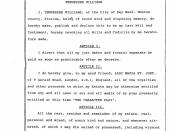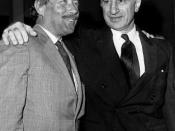Sexual Healing
Modern western culture prides itself on progress and tolerance, and the sexual revolution is a clear and unavoidable reminder of this. In the media and in our lives, sexual expression, a few decades ago would have been condemned, is becoming more mainstream, yet homosexuality is still an uneasy topic for most to discuss. Although the acceptance of homosexuality has increased over the decades, some problems that were present a century ago still exist today. The nature and the effects of pressure put on by society toward individuals to suppress homosexuality can be seen in Tennessee Williams' "Cat on a Hot Tin Roof" where the main character Brick, can not express his sexual preference due to the society he associates with.
"For Tennessee Williams, homosexuality was the site of manifold contradiction...his own identity was articulated in the tension between secrecy and disclosure contradictions" (Bibler 382). Such is the case of his creation Brick, the protagonist of the play, whose sexual identity is not clearly defined within the text.
His actions, however, indicate a suppressed homoerotic love for his college friend Skipper. One of the main indications of this is his treatment of his wife. Brick seems uninterested in Margaret, his wife, who is described as "beautiful" (915) and the lust of "other men"(930). He is constantly talking to her "without interest"(916), "absently" (919) and "indifferently" (921). He is even "indifferent to" (921) sex with his wife, which is normally a passionate act. Furthermore, his wife is constantly complaining of his lack of "longing for her" (621), and Brick, instead of giving her attention, repeatedly suggests that she "take a lover" (925). He is also disgusted by kisses from his wife who he "wipes off immediately with the back of his hand" (944). Brick's lack of intimacy, which...


